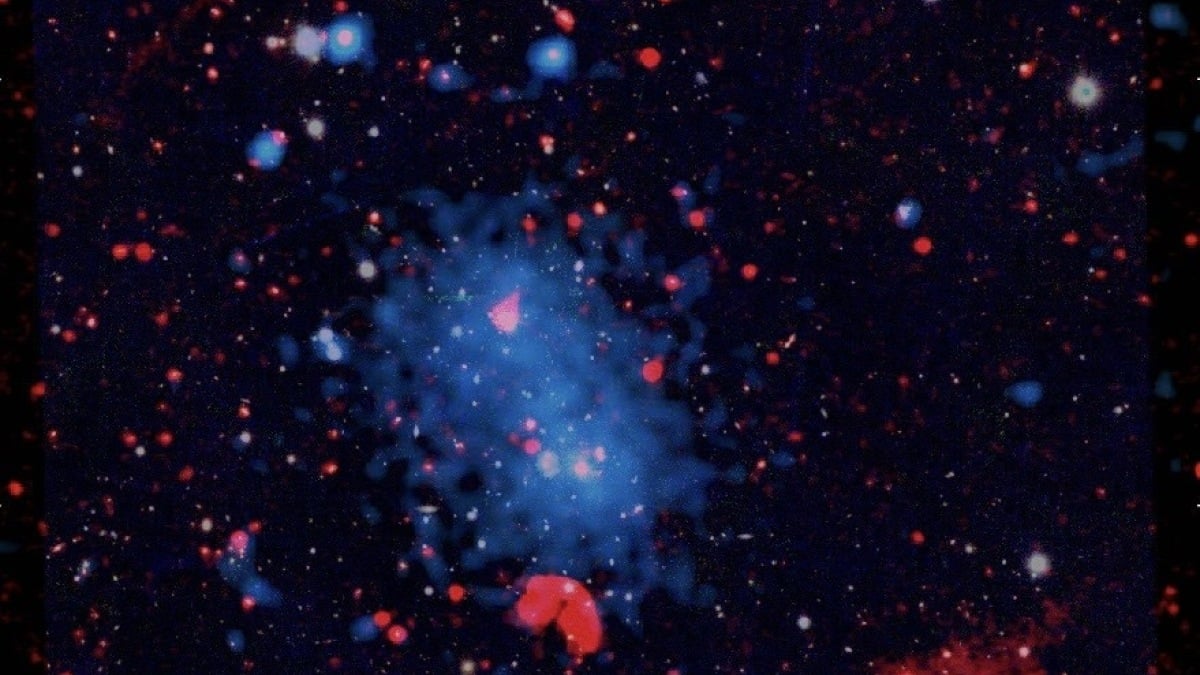Astronomers have spotted a pair of exotic features believed to be the aftermath of a colossal cosmic smackdown — not between two galaxies, but two groups of galaxies.
These glowing arcs of radio energy are known as “radio relics,” faint clouds resulting from powerful shockwaves surging through hot gas that fills the space amid a galaxy cluster.
The cluster, PSZ2 G181.06+48.47, is billions of light-years from Earth, but its image is less forgettable than its name. Using the Giant Metrewave Radio Telescope in India and the Very Large Array in New Mexico, a team of researchers spotted the arcs flanking the cluster like giant parentheses. The distance between the punctuation is an estimated 11 million light-years — about 100 times the span of the Milky Way.
That makes their separation a record holder — “the largest known to date,” according to a paper published on the discovery in The Astrophysical Journal.
What cracked the Milky Way’s giant cosmic bone? Scientists think they know.

An annotated view of a galaxy cluster reveals a rare pair of radio relics.
Credit: Kamlesh Rajpurohit et al /
Galaxies are often part of larger collections of galaxies, held together by gravity, according to NASA. These groups and clusters, containing hundreds to thousands of galactic neighborhoods, serve as building blocks for the larger structures of the universe. Clusters are also composed of scorching gas that reaches millions of degrees as well as dark matter, an invisible material that scientists don’t yet fully understand.
Mashable Light Speed
The team, led by Kamlesh Rajpurohit, an astronomer at the Harvard & Smithsonian Center for Astrophysics, thinks the newfound radio relics formed when shock fronts sped through space following two clusters wrecking. These waves can force particles to shine in radio light.
Though these two come as a pair, they’re not identical twins. The researchers describe the northernmost glow as brighter and polarized, meaning its light is moving in the same direction. Its companion to the south has a stranger ghostly shape and an energy pattern that may mean it was caused by a more powerful shockwave.

Using an enormous telescope in India and the Very Large Array in New Mexico, pictured above, a team of researchers spotted the arcs flanking the cluster like giant parentheses.
Credit: Bettymaya Foott / NRAO / AUI / NSF
The relics suggest the entire cluster is in the final throes of a merger set in motion a billion years before.
In the past, astronomers have dubbed clusters fun nicknames based on the shapes of their relics, such as the Toothbrush Cluster. Perhaps in the future this one will leave behind its numerical moniker for something a bit snazzier, like the Eyebrows Cluster or the Air Quotes Cluster. Until that time, you can call it Planck cluster G181+48 for short, Rajpurohit said.
Scientists discovered one other curiosity between the relics: a faint glow at the center of the cluster. This could be a so-called “radio halo,” another kind of radio source that emerges when churning gas and particles create turbulence after a violent cosmic crash.
Astronomers have previously detected less than 30 such clusters with relic pairs. But the upcoming Square Kilometre Array being built in South Africa and Australia could be a “game changer,” according to the paper’s authors.
“There could potentially be many more awaiting discovery in the era of large radio surveys,” they said.
